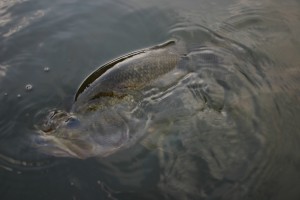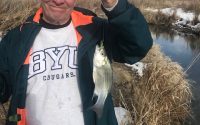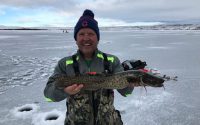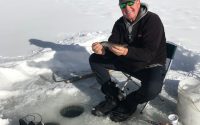Springtime … How To Entice Finicky Largemouth To Bite II

In Part One of this article, I wrote about how to handle catching largemouth bass while on or near their beds. In this post, let’s answer the question, “How do you get finicky largemouth to bite.” First of all, we are still talking about spawn and postspawn fish. One of the most difficult times to catch largemouth is when they’ve already been hooked. But, there is a relatively simple way to entice that fish to strike again.
As i’ve written before, bass do have personalities. They behave in unique ways. If a bass has already been hooked and either broke off or came unpinned and eventually takes its position back on the bed (nest), you must assess the personality first and then devise a plan to catch the fish. Pitch a large jig back on the nest. Most of the time, the bass will ignore the offering. Perhaps it will watch the lure but won’t make a move towards it. Then, after giving it a chance to settle down re-pitch the jig to the other side of the fish so the line will rub across its back. This will either bother the bass or maybe not. If it bothers the fish it will either leave the nest or turn to see what has just touched it. There will be times that the bass will strike whatever it sees after turning. But more times than not, it will seemingly remember the last encounter with a hook and will not immediately strike.
If the bass refuses to bite repeat the process. Pitch the jig so that the line rubs across the fish’s back. Then, watch for the response. If the bass stays on the bed and turns toward the jig, you WILL be able to catch that fish. if at that point, it leaves the bed, you must go back to square one and start the process all over again when and if it returns. Don’t waste too much time with that fish.
If the fish turns and faces the jig, twitch it ever so slightly with the thought that you are challenging the bass to do something about it. If the bass simply continues to watch the lure, repeat the process one more time. If the bass turns again, and just watches the lure, remove the lure from the bed and replace it with a much smaller offering. Try a bright colored tube, or grub perhaps, or even a small Senko or other stick bait (three inches or less). As before, pitch the lure to the opposite side of the bass so the line is pulled across its back. When the bass turns on the bait it will see the smaller offering and will generally strike.
Remember, move from large to small as the process of enticing a strike continues. It’s okay to have several rods on the deck with each rod rigged with larger-to-smaller versions of your lures.
Catching Cruising Bass
Catching cruising bass can be tough for everyone, and don’t believe there is a surefire way to ALWAYS catch them. However, cruising bass can be caught and the following methods are as good as they come when targeting spawn and postspawn fish. The first method is to cast a weightless Senko or other stick bait way ahead of the cruising bass, allowing the bait to slowly drift to the bottom. In this way, as the bass leaves the area of the boat and heads toward the Senko it feel secure, and there in front of it is a slow-falling morsel just waiting to be eaten. Make long casts and be very patient while the lure sinks.
Next, try casting a split-shot rig with a weightless tube rigged under a couple of tiny split shots with a leader around 24 inches in length (a little longer in grass and a little shorter in rocks). Try again to make long casts and allow the lure to slowly sink to the bottom. Remember to keep the boat away from the lure. At times with both the Senko and the split-shot rig, after the cast back off the area by releasing line so that the presentation still falls vertically but the boat and you are farther away.
The key here is to remove as many of the “fear factors” that a bass may have while still presenting something to eat. Stay back, make long casts and be extra patient as the lure sinks.
Post spawn largemouth will begin to eat within a few days of laying eggs. They will rest first and eat later, however if a lure is properly presented with no visible obstacles for the bass to negotiate, they will bite. Good luck and good fishing!










